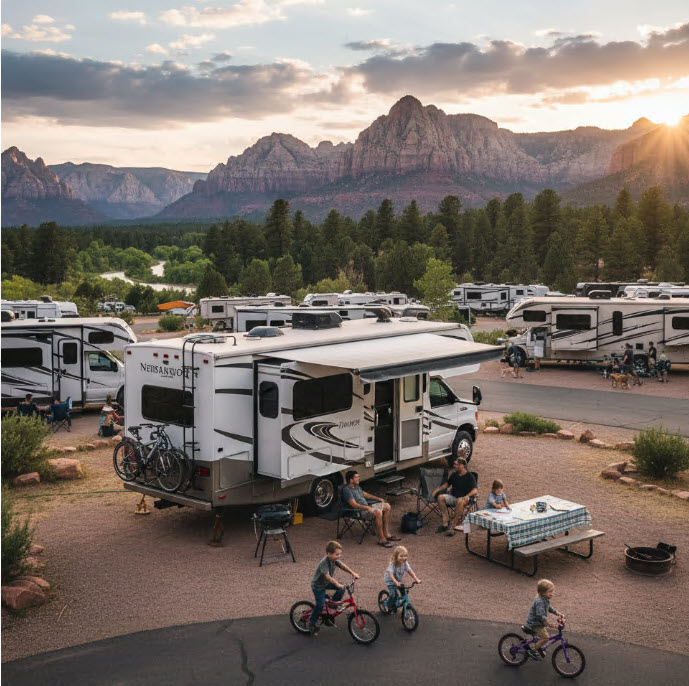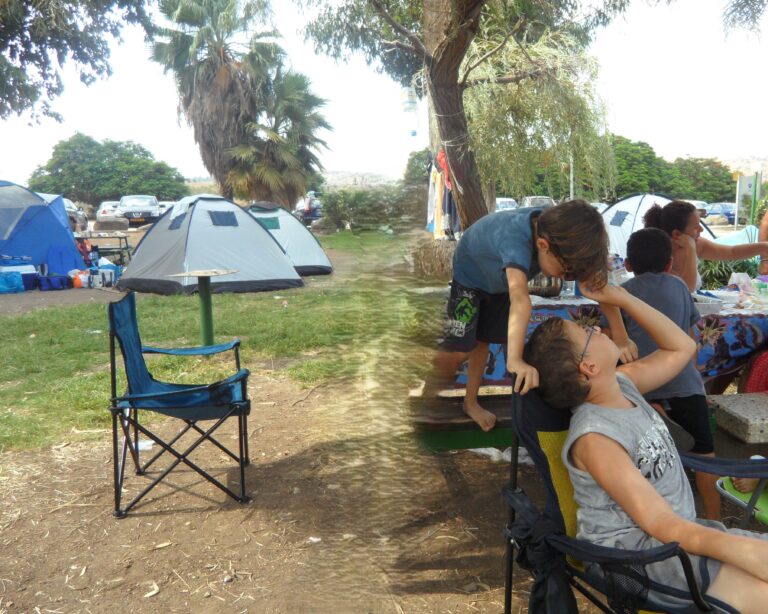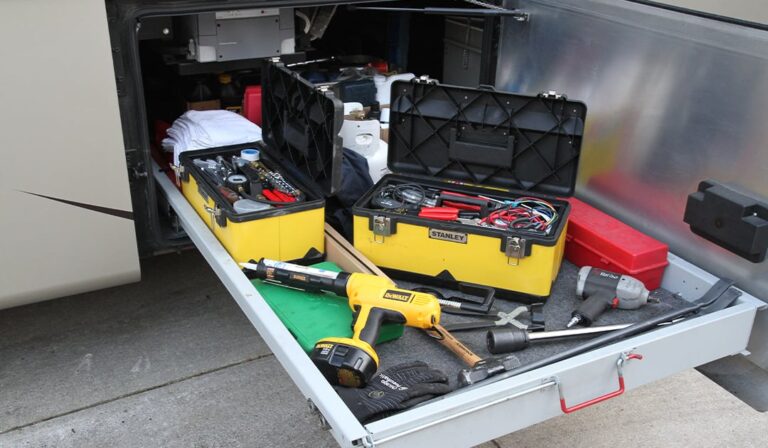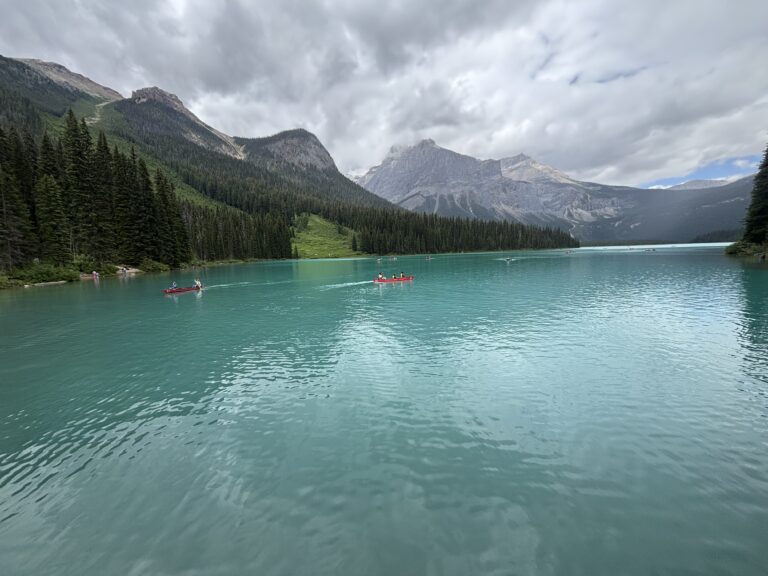The Ultimate Family Guide to RV Travel with Kids in the US: Everything You Need to Know
Introduction: Why RV Travel with Kids is the New American Dream Vacation
In an age of ever-increasing airfare, cramped hotel rooms, and restrictive schedules, the American family vacation is undergoing a revolution. Enter the Recreational Vehicle (RV): a home-on-wheels that promises unparalleled freedom, a built-in kitchen, and a front-row seat to the country’s most stunning natural landscapes. For parents, it’s the ultimate solution to travel logistics; for children, it’s a guaranteed, screen-free adventure.
This comprehensive guide is designed exclusively for families navigating the vast US RV Camping market. We’ll move beyond the glossy brochures and drill down into the real-world logistics, expenses, and practical tips—from choosing the right Bunkhouse RV for your crew to mastering the art of the Full Hookup Campground. Whether you’re considering a short-term RV Rental for a summer trip or planning an outright purchase, this is your step-by-step roadmap to making your first, or next, Family RV Trip US a success.
We understand that budget is a primary concern. That’s why we’ve compiled up-to-date, authentic data on the true cost of the RV lifestyle, addressing everything from mileage fees and insurance to regional fuel price differences and RV Rental Cost comparisons. This is the unvarnished truth, written by experienced road-trippers to save you time, money, and headaches.
Part 1: Choosing Your Adventure Vehicle – Renting vs. Buying
The first and most critical decision is determining your RV ownership strategy. This choice dictates your initial budget, long-term commitment, and the type of vehicle you’ll be driving. For families planning RV Travel with Kids, this decision becomes even more important – space, sleeping arrangements, and safety features matter more than ever. Renting an RV first can help parents test what layouts and amenities work best for their family before making a full purchase, ensuring comfort and convenience for everyone on the road.
RV Rental Cost vs. Long-Term Purchase Investment
| Factor | RV Rental (Short-Term: 1-2 Weeks) | RV Purchase (Long-Term: 5+ Years) |
| Initial Outlay | Low (Deposit + Daily Rate) | High ($15,000 – $350,000+) |
| Commitment | Low (Days/Weeks) | High (Financing, Registration, Storage) |
| Maintenance | Included in Rental Fee | Full Responsibility of Owner (Avg. $1000-$3000/year) |
| Usage | Great for testing the lifestyle and occasional trips. | Ideal for full-timers or families taking 4+ trips per year. |
| Vehicle Type | Class C (most common), select Class A and Travel Trailers. | All Classes, including specialized Bunkhouse RVs. |
| Average Daily Cost | $183 – $300+ (Includes mileage, insurance, fees) | $50 – $150 (Depreciation, maintenance, financing) |
Step-by-Step Guide to RV Rental for Your Family Trip
If you are new to RV Travel with Kids, renting a Class C motorhome is the universally recommended first step. It is the perfect blend of drivability (like a large U-Haul) and family space.
1. Select the Right Platform and Class
- National Chains (e.g., Cruise America, El Monte): Offer high inventory, standardized processes, and one-way rentals (though often at a premium). Typically stock older, high-mileage Class C models.
- Peer-to-Peer (e.g., Outdoorsy, RVshare): Offer a wider variety of makes, models, and specialized features (like a new Bunkhouse RV). Prices are often competitive, but policies and quality vary by individual owner.
2. Choose the Right RV Class for Your Family
The key is to always choose an RV that sleeps two more people than your family size. This ensures you have room for gear, a quick pull-out space, or a friend.
| RV Class | Ideal Family Size | Pros for Kids | Cons for Parents |
| Class C Motorhome | 4-6 People | Cab-over bunk (kid favorite), easy to drive, seatbelts for all. | Limited living space once slide-outs are in; fuel economy (6-10 MPG). |
| Class A Motorhome | 6-10 People | Huge space, full residential kitchen, great for large families. | Difficult to drive, massive fuel costs (4-8 MPG), very expensive rental/purchase. |
| Travel Trailer/5th Wheel | 4-12 People | Dedicated bunk rooms (Bunkhouse RVs), separation of space, can drop trailer at site. | Requires a heavy-duty truck for towing, complex setup/leveling. |
3. Budgeting for the True RV Rental Cost (Example: 7-Day Trip)
A $200/night Class C rental is rarely the final cost. Factor in these mandatory and hidden fees:
| Expense Item | Average US Cost (2024 Estimates) | Notes |
| Base Rental (7 Days) | $1,281 – $1,750 ($183 – $250/day) | Varies by season and region. Summer is peak. |
| Mileage Fees | $175 – $300 (Assumes 500-1000 miles @ $0.35/mile) | Check for ‘free miles’ packages. A major hidden cost. |
| Insurance/Protection Plan | $140 – $350 ($20 – $50/day) | Mandatory for most rentals. Your auto insurance may not cover RVs. |
| Prep/Cleaning Fee | $150 – $250 (Flat Fee) | Non-negotiable cost for sanitization/check-out. |
| Generator Use | $35 – $70 (Assumes 10-20 hours @ $3.50/hr) | Necessary for boondocking/off-grid camping and some AC use. |
| Total Estimated Rental Cost | $1,781 – $2,720 | This is before gas, campground fees, and food. |
Part 2: Mastering the Family RV Budget – Beyond the Rental Fee
When it comes to RV Travel with Kids, managing your family’s travel budget is just as important as choosing the right vehicle. Beyond the rental or purchase price, you’ll need to plan for campground fees, fuel, meals, attraction tickets, and unexpected expenses like maintenance or kid-friendly gear. Families often underestimate daily costs such as laundry stops, activity fees, and extra snacks for children. Building a realistic budget helps prevent financial stress and ensures your road trip remains focused on fun, comfort, and quality family time. A well-planned budget allows parents to relax and enjoy the journey—knowing every mile is covered.
Fuel: The Unavoidable Cost of Freedom
RV fuel consumption is notoriously poor. Knowing your vehicle’s estimated Miles Per Gallon (MPG) is crucial for budget planning.
| RV Type | Estimated MPG | Fuel Type | Cost to Drive 2,000 Miles (Avg. $3.30/gal) |
| Class A (Gas) | 6 – 8 MPG | Gasoline | $825 – $1,100 |
| Class C (Gas) | 8 – 10 MPG | Gasoline | $660 – $825 |
| Class B (Campervan) | 18 – 25 MPG | Diesel/Gas | $264 – $366 |
| Diesel Pusher (Class A) | 7 – 12 MPG | Diesel | $550 – $942 (Diesel prices often higher) |
Data Insight (Source: EIA/AAA 2024 Averages): The average US price for regular gasoline in 2024 hovered around $3.30 per gallon, but this masks huge regional variation. Driving from Oregon ($4.29/gal) to Mississippi ($2.70/gal) can mean a difference of over 50% in your gas costs. Always use an app like GasBuddy to find the cheapest fuel stops.
Campground Fees: The Full Hookup Reality
Campground costs depend heavily on location, amenities, and hookup type. A Full Hookup Campground (Electric, Water, Sewer) is essential for a stress-free experience when traveling with young children.
| Campground Type | Average Nightly Cost (US, 2024-2025) | Amenities | Best For |
| Dry Camping/Boondocking | $0 – $20 | No hookups, minimal facilities. | Budget-conscious, short stays, self-contained RVs. |
| State Parks (Electric/Water) | $30 – $55 | Electric hookup, central water/dump station. | Nature-focused trips, quiet, smaller RVs. |
| Private/KOA (Full Hookup) | $55 – $90 | Electric (30/50 amp), water, sewer, pool, laundry, Wi-Fi. | Families, first-timers, stays over 3 days. |
| Luxury RV Resort | $90 – $150+ | Concierge, spas, premium sites, activity director. | “Glamping” experience, long-term winter stays (e.g., Florida). |
Pro Tip: Memberships Save Money
- Passport America: 50% off nightly rates at participating parks (primarily off-peak/mid-week).
- Harvest Hosts/Boondockers Welcome: Pay an annual fee ($99 – $139) for free overnight stays at wineries, farms, museums, and breweries across the US—a fantastic way to break up long drives and support local businesses.
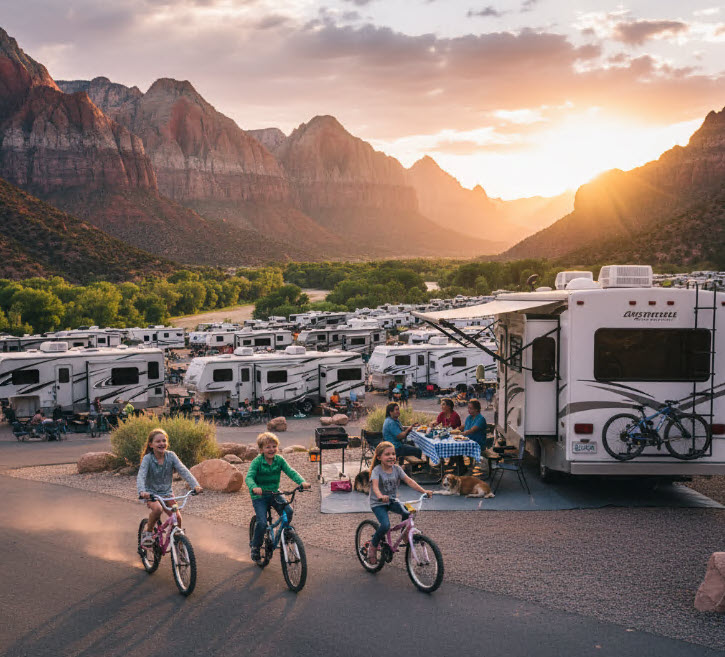
Sample 7-Day RV Trip Budget (Family of 4, Class C Rental, 1,000 Miles)
This conservative estimate shows the all-in cost of a moderate Family RV Trip US.
| Category | Estimated Cost | Details |
| RV Rental (Total) | $2,250 | Mid-range of the estimate in Part 1. |
| Campground Fees (6 Nights) | $420 | 6 nights @ $70/night (Full Hookup average). |
| Fuel | $750 | 1,000 miles @ 9 MPG @ $3.30/gal. |
| Food/Groceries | $600 | Preparing most meals in the RV kitchen. |
| Park Entrance/Tours/Misc. | $300 | National Park pass ($80 Annual Pass recommended), souvenirs, activities. |
| TOTAL ESTIMATED TRIP COST | $4,320 | A premium vacation, but often less than flights/hotels/rental cars for a family. |
Part 3: The Family-First RV: Floorplans, Comfort, and Bunkhouse RVs
Choosing a family RV is not about luxury; it’s about functionality, especially when it comes to sleeping arrangements and separation of space. The gold standard for RV Travel with Kids is the Bunkhouse RV.
Understanding Bunkhouse Floorplans
A Bunkhouse RV (BH or Bunk Model) is any RV with a dedicated, separate sleeping area for children beyond a convertible sofa or dinette.
| Bunkhouse Type | Pros | Cons | Ideal Age Range |
| Double-over-Double Bunks | Maximum sleeping capacity (4 kids); common in Class C/Travel Trailers. | Can feel cramped in small units; bottom bunk often used for storage. | All ages. |
| Cube/Versa Bunks | Large, separated room at the rear; sometimes convertible into a desk/play area. | Takes up significant square footage; typically found in longer Class A/Fifth Wheels. | Older kids, teens. |
| Cab-Over Bunk (Class C) | Standard feature, provides an “attic” play area, excellent separation. | High climb; can get hot in summer; cuts off access to the cab. | Young children (3-12). |
Top 5 Recommended RV Models for Families (2024-2025 Focus)
Based on current US market sales, reliability, and family-friendly floorplans.
- Forest River Forester 3251DSLE (Class C): The Bunkhouse King. Sleeps up to 10 with a cab-over bunk, bunks in the hallway, and a private rear bedroom. Excellent choice for rental due to high availability.
- Winnebago Solis 59PX (Class B/Campervan): The Adventure Family. Sleeps 4 using the pop-top roof. While small, the versatility and drivability make it perfect for families seeking National Parks that enforce length restrictions.
- Jayco Eagle 332BOK (Travel Trailer): Towable Comfort. Features an expansive bunkhouse that can function as a second living room. Ideal for families with a suitable tow vehicle who prioritize a spacious campsite experience.
- Thor A.C.E. 32B (Class A): The Affordable Bus. One of the most popular Class A options for families due to a dedicated bunk area and competitive price point compared to luxury diesel pushers.
- Keystone Montana High Country 381TB (Fifth Wheel): The Luxury Family Retreat. Sleeps up to 10 with a three-bunk bedroom, separate kid’s bath, and large living area. Requires a heavy-duty pickup truck.
Essential Interior Upgrades for RV Travel with Kids
- Noise Management: Add a white noise machine near the kids’ sleeping area. The thin walls of an RV transmit every sound.
- Power/Charging: Install a multi-port USB charger hub. Kids’ devices (tablets, consoles) will constantly need charging, and standard RV outlets are few.
- Storage Nets: Use stick-on mesh nets or soft baskets to corral small toys, books, and tablets near bunks. This is a game-changer for keeping the limited RV space tidy.
- Blackout Curtains: Crucial for allowing parents to stay up after the kids go to bed, or for daytime naps. Standard RV blinds are usually too thin.
Part 4: Planning Your Family RV Trip US – Step-by-Step Logistics
A successful RV trip with kids is 90% preparation and 10% reaction. Follow this step-by-step process for a smooth journey.
Step 1: Route Planning and Campground Booking (The 6-Month Mark)
- Determine Your Pace: RVing is slow. Aim for a maximum of 250 miles or 4-5 hours of driving per day. Long drives with children in an RV can be miserable.
- Book National Parks FIRST: Many National Park and popular State Park campgrounds (Yosemite, Yellowstone, Grand Canyon) require booking up to 6 months to one year in advance. Use the recreation.gov website.
- Mix Campground Types: Interspace expensive, amenity-rich Full Hookup Campgrounds (KOA, private resorts) with cheaper, more rustic State/National Park sites to balance the budget and experience.
Step 2: Packing and Inventory (The 1-Week Mark)
- The RV Kitchen Principle: Only pack the essentials. RV cabinets are small. Stick to reusable containers and multipurpose kitchen tools. Example: A single instant pot or air fryer is better than three different pots/pans.
- Clothes in Totes: Instead of trying to use the small drawers in the RV, pack each person’s clothes for the trip into one large, labeled plastic tote. The tote slides easily under the dinette or bed, eliminating unpacking stress.
- The Tool Kit and Maintenance: An RV requires a small emergency kit, even for rentals. Must-haves: Surge Protector (crucial for protecting the RV’s electronics from campground power issues), sewer hose and gloves, leveling blocks, and a basic tool kit.
Step 3: Departure and the RV Travel with Kids Safety Checklist
- Walk-Around Check: Must become a ritual before every drive. Check all tires, confirm slide-outs are locked, antenna is down, all cabinets are latched, and the refrigerator door is secured.
- Child Safety Seats: Ensure all car seats are correctly installed. Note that many Class C RVs have LATCH systems and tether anchors in the dinette seats, but Class A motorhomes often do not. Verify your rental’s belt system.
- Power Down: Before disconnecting from the Full Hookup Campground, turn off the main breaker to the RV. This protects your electrical system and prevents the RV from tripping the campsite’s breaker on the next connection.
Step 4: The Campground Setup (The 2-Hour Rule)
- The Kids’ Jobs: Assign specific, simple, and crucial setup tasks to the children immediately upon arrival. This channels their energy and makes them part of the team. Example: Placing the leveling blocks, setting out the door mat, securing the picnic blanket.
- Leveling: Use a level app on your phone or a simple bubble level. Leveling the RV is essential for comfortable sleeping, proper draining of the shower/sink, and ensuring the RV refrigerator functions correctly.
- Sewer Last: Connect electric, then water, and finally the sewer line (the “stinky slinky”). When leaving, disconnect the sewer line first, then water, then electric. This order prevents contamination and frustration.
Part 5: Staying Sane on the Road – Tips for Long-Term RV Travel with Kids
The reality of living in a confined space for an extended period requires strategies to manage stress, mess, and boredom.
The Entertainment & Education Toolkit
- The “RV School” Approach: Even during vacation, stick to a small routine. Designate one hour in the morning for reading or nature journaling. Use the trip itself as a lesson. Example: Study the geology of Utah as you drive through it.
- Screen Time Management: Embrace the screens during long drives, but enforce a “no screens outside the RV” rule. The point of US RV Camping is to be outdoors. Download movies and games beforehand, as campground Wi-Fi is notoriously unreliable.
- “Campground Loop” Biking/Scooting: The simplest and best solution for burning off energy. Pack bikes or scooters; letting kids explore the campground loop safely is a staple of the RV experience.
Meal Planning in the Compact Kitchen
- Minimalist Menu: Stick to simple, one-pot or grill-friendly meals. Chili, tacos, foil-packet dinners, and pasta are staples. Elaborate cooking leads to a quick mess and limited space.
- Grill or Fire Pit: Maximize outdoor cooking. This keeps heat and smells out of the RV and is a fundamental part of the camping experience for children.
- Breakfast Freedom: Allow the kids to self-serve easy breakfasts like cereal or bagels. This frees up the parents to manage morning logistics (like draining tanks) without being interrupted.
Laundry, Bathroom, and Black Tank Management
- Laundry Strategy: Never plan to do laundry in the RV washer/dryer (if you even have one). Use the campground laundry facility or, for longer trips, find a laundromat in a small town. It’s faster and cheaper.
- Black Tank Protocol (Crucial): The “Black Tank” holds sewage. Use plenty of water with every flush to ensure proper breakdown and prevent the dreaded “pyramid of death.” Never leave the black tank valve open—only dump when it’s at least 2/3 full to ensure a forceful, clean flush.
Conclusion: The Family RV Investment is Worth the Cost
RV Travel with Kids offers a unique opportunity for US families. It is not just a vacation; it is a lifestyle investment that fosters resilience, collaboration, and a deep appreciation for the American landscape. While the RV Rental Cost and fuel expenses are significant, the ability to pack up your entire family’s world and move it to a new, breathtaking location every week is priceless.
From finding the perfect Bunkhouse RV to budgeting for your Full Hookup Campground stays, the path to a successful Family RV Trip US is now clear. Get out there, hit the road, and start making memories that cramped hotel rooms simply cannot offer.

